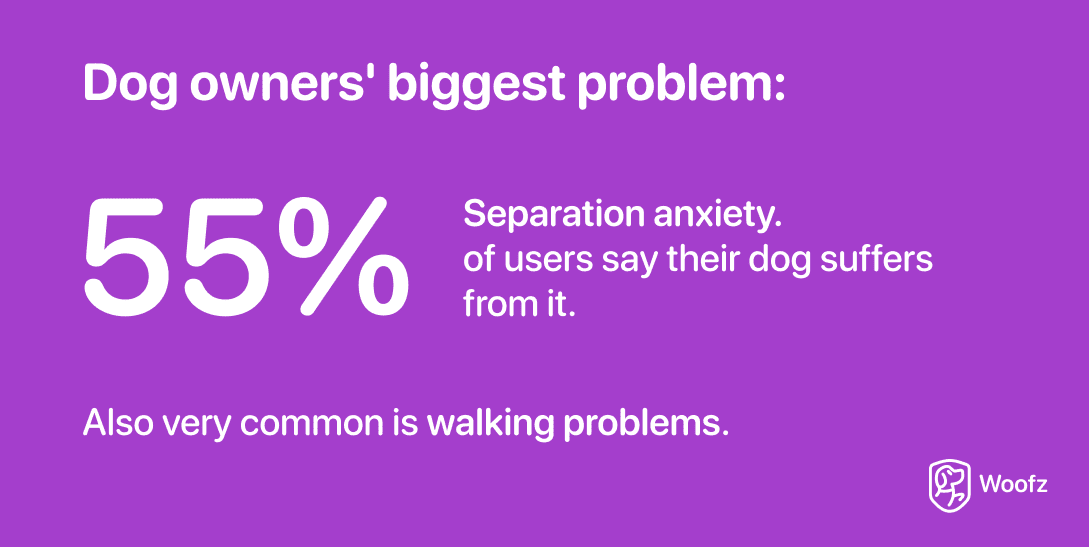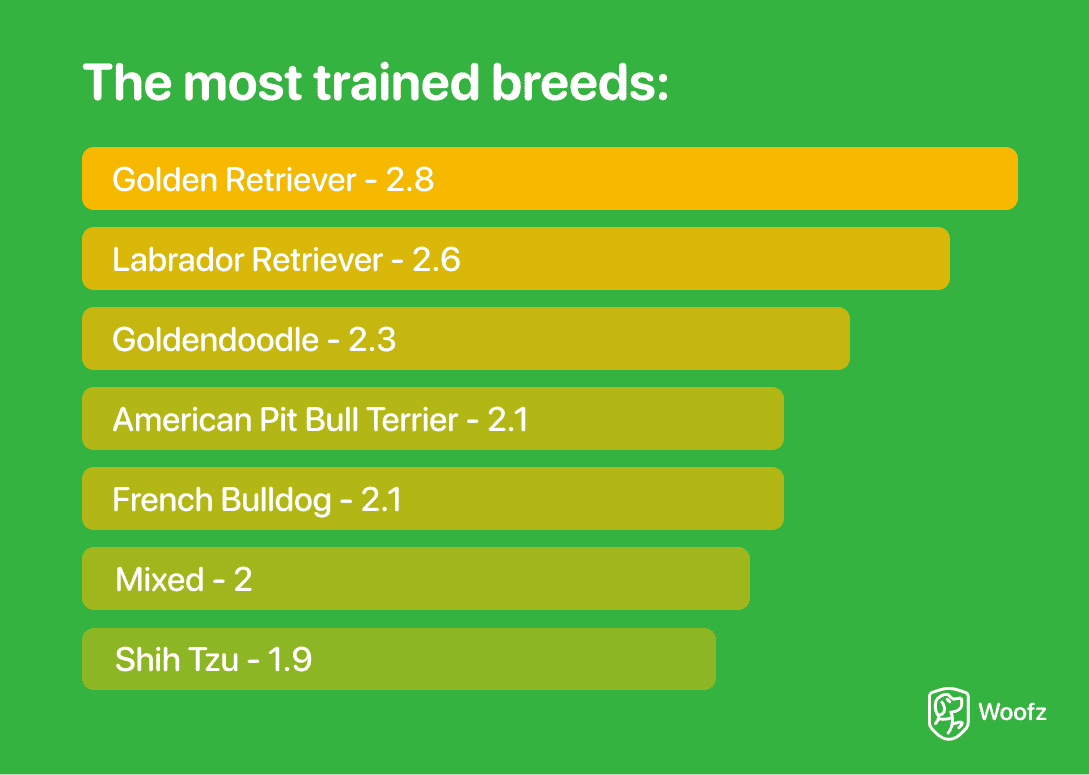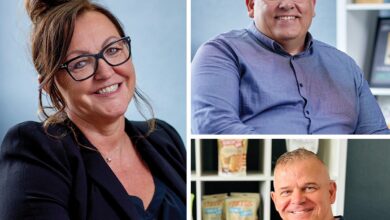
 The Woofz app knows a thing or two about dogs. What started out as 3 training courses in 2020 has grown into a one-stop pet hub featuring over 70 training videos, a tracker functionality and a puppy journal. Working with Cynologists (a trained specialist in the fields of dogs) at the heart of the advice, the app has had more than 4 million downloads and counting. Woofz lifts the lids, the most popular breeds and need-to-know facts and how to tackle common behavioural problems with your beloved pooch.
The Woofz app knows a thing or two about dogs. What started out as 3 training courses in 2020 has grown into a one-stop pet hub featuring over 70 training videos, a tracker functionality and a puppy journal. Working with Cynologists (a trained specialist in the fields of dogs) at the heart of the advice, the app has had more than 4 million downloads and counting. Woofz lifts the lids, the most popular breeds and need-to-know facts and how to tackle common behavioural problems with your beloved pooch.
According to Woofz stats, these three breed types are the most popular: Mixed breed (37% of the users), Golden Retriever (7% of the users), and Labs (6.2% of the users).
The popularity of mixed breed pups correlates with many Woofz users having adopted dogs from shelters. Owners of rescues are especially keen to seek the help of professionals – particularly if the dog is well beyond puppy years.
Unsurprisingly Golden Retrievers and Labrador Retrievers are the second and third most popular breeds owned by users of the Woofz app.These people-oriented, loving characters with chilled temperaments, and high trainability skills are impossible to resist when looking for a dog. Moreover, their loving nature makes them the perfect addition to a family, and furry best pal for kids.
The fourth place belongs to German Shepherds. Despite their courageous and protective characters, these dogs are known as very loyal family pets. Their high prey drive makes them easy to train, and you can just do that with their favourite toys! Their popularity within services such as the police and military indicates their intelligence and propensity for high levels of training.
Mixed breed facts:
Stray dogs often have one distinct characteristic: fearfulness. Therefore, if you decided to adopt a dog from the street, you will definitely do a good thing. However, you should keep in mind that such a character trait won’t be easy to get rid of.
If you’re unsure at point of adoption what breed your new rescue pup is,you can order a DNA kit in a vet clinic or a DNA company. One of the many upsides of mixed-breed dogs is that they’re unique in their behavioral tendencies and are often free from breed-typical genetic problems.
Golden Retriever facts
Notoriously excellent family members – Retrievers are renowned for being sociable and relatively easy to train. They also need to constantly have something to chew on (teasers, cones) and require a lot of play time and games. Training: it’s crucial to properly socialise your puppy, teach basic obedience, add some mental stimulation (especially chew toys to avoid chewing misfortunes), and active games. Did you know, hey also adore swimming!
Labrador facts
The Lab is a smart family dog, very trainable with a stable character, friendly and loyal. They need long walks with plenty of active exercises (fetch, agility, intelligence games, chew toys). Training; it’s crucial to properly socialise your puppy, teach basic & advanced obedience, and stimulate them mentally.
Which dogs receive new commands the most often?
According to our stats, the owners of Goldens and Labs are the ones who train commands the most often. This goes some way to showing how this breed is quick-witted and easy to teach new commands and tricks, which helps the owners to stay motivated and engaged in the training process.
The third place in learning commands belongs to the owners of Goldendoodle (they also belong to our top 10 popular breeds). A Goldendoodle is a cross between a Poodle and a Golden Retriever, they are not only super cute but also very smart dogs (both Poodle and Golden Retrievers are considered to be one of the smartest dogs in the world 10 of the Smartest Dog Breeds (thesprucepets.com) https://www.thesprucepets.com/
Goldendoodle facts:
As well as being extremely cute and allergy-friendly, Doodles are also loyal, playful, and active dogs. They have friendly and loving characters and can live perfectly with children and animals. They’re rarely aggressive (if socialized) and smart dogs that are easy to train.
Lazy dogs
There is no such thing as a lazy dog, but simply differing motivation and activity levels! For example, the activity levels of American Pitbull and French Bulldogs are diametrically opposed (not to mention the health issues of Brachycephalic breeds), which is why we can’t even imagine our tiny Frenchie jumping 5 feet up to catch a frisbee. But it’s not their laziness, it’s just genetics. What’s more, both breeds can become either well-trained or “lazy” depending on their owners. That’s why we always need to start by training ourselves.
Low motivation, on the other hand, can happen to any dog, and the most common reasons are a) health issues, b) wrong reinforcer (e.g., treats are not tasty enough, your dog would prefer a toy instead of food), c) your dog breed has a low prey drive and with age, they might need to be a food alternative in order to be motivated to learn something new.
According to Woofz stats, the dog breed that learns the least commands is the Chihuahua. However, it does not impose the laziness or poor trainability of this breed (on the contrary, Chihuahuas are very intelligent), but probably shows the lack of motivation of their owners. Who needs to train such a small dog after all, if, in any uncomfortable situation, you can just pick them up and run, right?
This does not mean though that it’s the right approach. We need to remember that even the smallest furry babies are still dogs, that need training corresponding to their needs and breed features. Lack of training causes anxiety, fear, and aggression in such dogs, which is not only embarrassing for their owners but also harmful to their mental state and sometimes can lead to dreadful consequences. That’s why you should not forget that by training your dog, you also give them love and care!
Top problem behaviors according to our dog trainers
55% of our users say that their dogs suffer from separation anxiety. However, it’s essential to understand the difference between separation anxiety and a simple dislike of being left alone.
Separation anxiety is a behavioral panic disorder or a phobia of being left alone, separated from the primary caregiver(s). The only way to treat it is through gradual desensitization to leaving cues and absences.
Separation anxiety symptoms:
– Vocalization (barking, whining, howling)
– Pacing
– Panting
– Scratching at the door
– Urination/defecation
– Destructive behavior
Usually, the dog starts panicking even before the person leaves, e.g. triggers such as putting on a coat, putting on shoes, or picking up keys!
Dislike being left alone
Nearly all puppies and rescues have this initially. Dogs with a traumatic past or no history of people leaving and then returning may be concerned that being left alone is dangerous. This can develop in adult dogs, too, usually when they’re under-stimulated and bored. This is then usually a form of boundary frustration (when the dog is unable to cope with having a physical barrier between themselves and something that they want to access).
The reasons why so many dogs suffer when home alone may be various: a) the owner cultivated the behavior unconsciously (e.g., ove rexcited greeting with a dog), b) dogs were used to always being near the owner all the time (lack of house training), c) boredom (lack of environmental enrichment when the dog’s alone), etc.
What can you do about it?
Understand whether your pet has a SA or simply does not like to be home alone
If your pet has separation anxiety, the first thing to start would be desensitizing your dog to all leaving cues (picking up keys, bag, putting on shoes, etc.) until they are completely calm. And remember, no over excitable greeting once you come back home! After, you can introduce short periods of separation at home – if you go to the toilet don’t forget to close it; if you’re cooking, leave the dog in another room; if you work remotely start to implement separation periods (start with 10 minutes and gradually increase the time).
If you have a dog who does like to stay home alone, you should teach them that staying alone is ok (use a crate or a separate room and introduce short absences) and always leave them something to do to prevent boredom
And finally, if you feel like it’s been weeks and nothing changed, seek thet the help of a professional
© Home Alone Course
Another common problem is leash pulling. And it’s not a big surprise as we can see this happening every day with various dogs. The most common reason is “overstimulation” by the outside world. Even things that we may not notice can be a stimulus for our furry pals (a smell, a noise, something in the bushes) that makes them want to run either away from it or towards it. That’s their nature.
The thing is dogs do not pull because they want to show their dominance, they just want to explore the world, and our task, as humans, is to teach them to do that while being calm and connected: first by getting them used to the equipment, then by teaching them basic cues and adding some anti-pulling lifehacks (stops, directional changes, asking for alternative behaviors, etc.), and later by loose leash training.
To better deal with the leash-pulling problem, you can also give your dog something to chew 30 minutes before walking to lower the stress levels; manage the frequency and duration of walks according to the dog’s needs; for overstimulated dogs, you should teach them to relax during walks by stopping in a quiet place (forest, park, beach) and staying there (with a long line) for 10/15 minutes.
© Mastering the Dog Walk Course
When dealing with problematic behaviors the most important thing is not to humanize our furry friends and not to attach our inner personal feelings to their behavior. As the saying goes “If you feel disrespected when your dog pulls the leash, then you probably have much bigger issues than a dog pulling” © Matt Beisner
Whatever the dog does, they don’t do that to make us feel bad, they do it because they are dogs! And our task, as humans, is to teach them what is appropriate and what’s not in our world.















